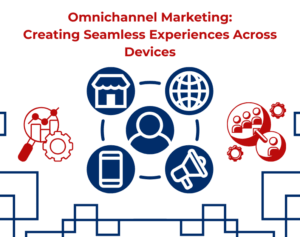Omnichannel Marketing: Creating Seamless Experiences Across Devices

What Is Omnichannel Marketing?
Omnichannel marketing is a strategic approach that delivers a cohesive brand experience across all digital and physical channels. Unlike multichannel marketing, which may use several platforms independently, omnichannel marketing ensures each platform communicates and connects with others. The goal is to create a unified, customer-centric journey that feels natural and uninterrupted regardless of device or touchpoint. It’s about making every interaction with your brand feel connected, personalized, and relevant.
Why Omnichannel Marketing Matters Today
Consumers Expect Consistency
Modern consumers frequently switch between devices—from desktops to mobile apps to in-store experiences. They expect seamless transitions and consistent messaging. If a brand delivers a promotion via email, customers want to see the same offer on social media, the website, and even in-store. Omnichannel marketing meets these expectations by ensuring that communication remains uniform across all brand channels.
Higher Engagement and Loyalty
Brands that implement an omnichannel strategy see higher engagement rates, increased customer satisfaction, and stronger loyalty. According to research, companies with strong omnichannel engagement retain on average 89% of their customers, compared to 33% for those with weak engagement. With a connected experience, customers feel understood and valued, leading to long-term brand relationships.
Increased Revenue Opportunities
When businesses align their channels, they not only enhance the user experience but also unlock more revenue potential. Seamless experiences reduce cart abandonment, encourage repeat purchases, and allow for more personalized upselling or cross-selling.
Key Components of a Successful Omnichannel Strategy
Unified Customer Data
Start by centralizing customer data. Use a CRM or CDP (Customer Data Platform) to collect and organize interactions across channels. This allows you to understand behaviors, preferences, and pain points. By leveraging this data, you can craft tailored experiences that resonate with your audience.
Consistent Branding and Messaging
Your tone, visuals, and message should be uniform across platforms. Whether it’s a mobile ad, a website banner, or an in-store flyer, ensure that customers immediately recognize your brand. Consistency builds trust and strengthens brand identity.
Channel Integration
Ensure all platforms work together. For example, a customer should be able to start a purchase on mobile, ask questions via live chat, and complete the checkout on a desktop—all without losing progress or context. This type of interoperability between systems enhances the overall shopping experience.
Real-Time Personalization
Use data to personalize experiences based on user behavior. Tailored product recommendations, personalized emails, or dynamic website content can boost conversion and satisfaction. The more relevant the interaction, the more likely a customer is to engage.
Continuous Optimization
Track performance across all channels. Use A/B testing, analytics, and feedback to refine your approach and improve each touchpoint. Optimization is not a one-time effort—it’s an ongoing process that ensures your omnichannel strategy remains effective.
How to Implement an Omnichannel Strategy
Step 1: Map the Customer Journey
Outline every interaction your customers may have with your brand—from discovery to post-purchase. Identify gaps, friction points, and opportunities for improvement. Use this map to design a journey that anticipates user needs and exceeds expectations.
Step 2: Choose the Right Channels
Not every channel is necessary. Focus on where your audience is most active. Common channels include:
- Website
- Mobile apps
- Social media platforms
- In-store touchpoints
- Live chat or chatbots
Each channel should serve a specific purpose in the customer journey and align with your business objectives.
Step 3: Integrate Your Tech Stack
Ensure your CRM, email platform, analytics, and POS systems are connected. This integration is crucial for real-time data syncing and a smooth user experience. Disconnected systems can lead to inconsistent communication and missed opportunities.
Step 4: Train Your Team
Everyone from sales to customer support should understand how to use omnichannel tools and deliver a consistent brand experience. Provide training, documentation, and cross-channel communication protocols. A knowledgeable team can adapt quickly and provide better customer service.
Step 5: Launch, Measure, Optimize
Start small with a pilot campaign. Monitor KPIs like conversion rate, average order value, and customer retention. Use insights to fine-tune and scale your strategy. The more data you gather, the better you can adjust your approach to meet evolving customer expectations.
Real-World Example: Starbucks
Starbucks is a prime example of omnichannel success. Their rewards app allows customers to order and pay ahead, collect rewards, and receive personalized offers. Users can reload their cards via mobile, desktop, or in-store, with all updates syncing instantly. This creates a frictionless experience that boosts loyalty and sales.
Additionally, Starbucks sends personalized notifications about offers, birthday rewards, and nearby store updates, creating multiple touchpoints that drive continued engagement. It’s a textbook case of how integrated systems and customer data can deliver real value.
Common Challenges and How to Overcome Them
Data Silos
When data is trapped in separate systems, it hinders personalization. Invest in integrated platforms and break down organizational silos. Unified data systems are the foundation of any effective omnichannel strategy.
Inconsistent Messaging
Disjointed content across channels can confuse customers. Develop brand guidelines and approval workflows to maintain consistency. Centralize content management to ensure that messaging stays aligned at all touchpoints.
Resource Constraints
Omnichannel requires effort and investment. Start with your most impactful channels and expand as you grow. Leverage automation tools and partnerships to streamline execution without overextending your team.
Final Thoughts
Omnichannel marketing is no longer optional—it’s essential for brands looking to stay relevant and competitive. From social media marketing management to ppc ads and google ads, an integrated approach ensures you not only meet customer expectations but also foster deeper loyalty and drive long-term growth.
Start small, stay consistent, and let data guide your evolution into a truly omnichannel brand. The brands that succeed will be those that treat every channel not as a silo but as a unified thread in a complete, personalized customer journey.
Schedule your consultation with Utah Digital Marketing Experts today to learn how we can create a fully connected marketing strategy for your business.




